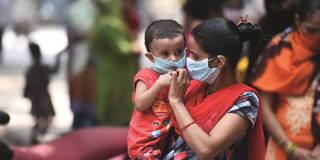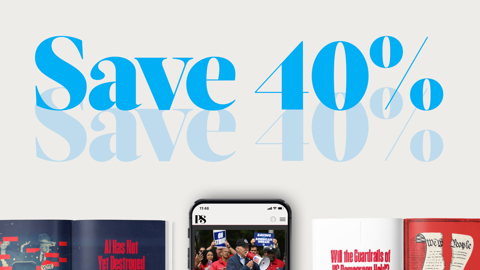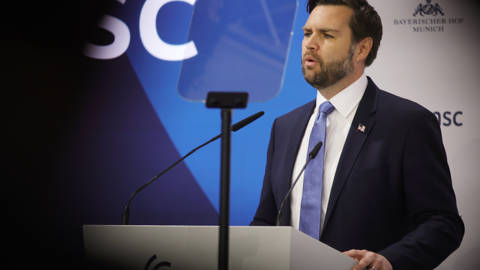OnPoint Subscriber Exclusive
Interviews feature exclusive interviews with prominent leaders and thinkers on issues of global importance.

The Key to Development
Gender is a factor in almost every area of development, from economic outcomes to public health. Now that the COVID-19 pandemic has imposed disproportionate costs on women and girls, global efforts to ensure equality will have to be redoubled.
As the president of the Gender Equality Division and director of the Vaccine Development and Surveillance, and Enteric and Diarrheal Diseases programs at the Bill & Melinda Gates Foundation, Anita Zaidi is one of the world’s leading voices on issues affecting women and girls. This May, she spoke with PS about the gendered nature of the COVID-19 pandemic and what it will take to ensure continued progress toward the Sustainable Development Goals (SDGs), despite the setbacks of the past year and a half.
The Gender-Poverty Link
Project Syndicate: In November 2020, you became the first president of the newly created Gender Equality Division at the Bill & Melinda Gates Foundation. When explaining what drew you to the role, you said, “The root cause of a lot of disease is poverty-related, and poverty is sexist. Without addressing gender inequality, progress on both health and development will be stunted.” What are some of the most significant ways poverty disproportionately affects women, and how would progress on gender equality lift more people out of poverty?
Anita Zaidi: Without a doubt, poverty widens and deepens existing inequalities. Gender inequality persists everywhere, but the experience is shaped by interlinked factors that build upon and extend beyond gender. These include race, socioeconomic class, age, sexual orientation, and disability.
Women who are poor have fewer rights, fewer protections, and fewer choices. As a doctor, I’ve seen firsthand how women skip hospital appointments because they cannot take time off from work, don’t have their husband’s permission to leave the house (sometimes even for health emergencies), or are needed for unpaid family tasks. I’ve seen adolescent girls drop out of school to get married so that they will no longer be a financial burden to their families. And I know that many mothers face an impossible choice between caring for their children and working outside the home.
Gender equality is central to lifting people out of poverty. We know that interventions such as childcare support and universal health care are vital for women’s well-being and their economic prospects. Government investment in transportation, electric grids, sanitation, and water can support women and alleviate the burden of unpaid work.
That is why the United Kingdom’s decision to cut development aid is a blow to poverty-reduction efforts, particularly for women and girls. It is all the more painful given that the UK has been a champion for women and girls in the past. At a time when all the evidence points to a gendered pandemic, with women’s poverty levels rising sharply, donors need to step up, not stand down.
PS: UN Women and United Nations Development Programme data show that “for every 100 men aged 25 to 34 living in extreme poverty” this year, “there will be 118 women.” That is a total of 435 million women and girls living on $1.90 per day or less, including 47 million who were pushed below the poverty line by the pandemic. This gap is expected to increase to 121 women per 100 men by 2030. What interventions can reduce women’s vulnerability to future shocks?
AZ: Right now, there is a small window of opportunity to address inequalities and protect women in future crises. This means introducing social protection programs and policies for the most vulnerable people, especially women in the informal economy. Governments should also accelerate the digitization of identification systems and payment platforms to ensure that the most economically marginalized women can access financial services.

Winter Sale: Save 40% on a new PS subscription
At a time of escalating global turmoil, there is an urgent need for incisive, informed analysis of the issues and questions driving the news – just what PS has always provided.
Subscribe to Digital or Digital Plus now to secure your discount.
Investment in high-quality, affordable childcare is essential for women – and for building an inclusive, resilient economy more generally. By providing lines of credit and other forms of finance, governments can bolster women-owned businesses.
PS: If you could wave a magic wand and enact any global anti-poverty intervention, where would you point it first? What are the biggest obstacles to it that need to be overcome?
AZ: Gender equality, of course. The best way to address poverty is to break down the barriers that prevent women from reaching their potential. Women face barriers across the board – from making decisions about their bodies and accessing health care and education to pursuing leadership opportunities. We have evidence to show that women can have an outsize impact on the economy. Already, they contribute 37% of global GDP, including through unpaid work, which generates $11 trillion every year.
I would be remiss not to mention that right now, getting vaccines to people in low-income countries is a huge obstacle. COVID-19 has caused large-scale unemployment and reduced incomes across many sectors. The pandemic has also disrupted vital non-COVID-19 vaccination programs around the world, which will significantly affect health care and mortality.
Building Back for Women
PS: In an interview last year, you said that COVID-19 had exposed how “our current world is basically built on the backs of women and women’s unpaid labor.” How should care and other unpaid work be reshaped or revalued after the pandemic? Which structures to support women’s economic participation and empowerment need to be “built back better” (or from scratch)?
AZ: Make women front and center in policymaking and policy implementation. Women’s ability to work has direct consequences for poverty reduction, because the amount of time devoted to unpaid care negatively correlates with female labor-force participation.
Proven solutions include investing in public services – such as piped water, sanitation, electricity, and transport – to reduce the drudgery and time women spend on household chores, and providing childcare support and subsidies to help households better manage paid work and unpaid care.
At the same time, evidence shows that workshops, media campaigns, and school-based programs can help change attitudes toward unpaid care work. Policies that encourage family-friendly leave and work arrangements can support women both directly and indirectly. Governments and donor organizations also need to ensure that childcare is included in financial stimulus and relief packages.
PS: You’ve mentioned that childcare should be treated as a “vital piece of public infrastructure.” What are some of the more underappreciated benefits – economic or otherwise – of investing in childcare?
AZ: Investing in childcare is a win-win. The sector employs women and provides opportunities for women to own childcare businesses while at the same time freeing up other women to participate in paid work or take advantage of education or training opportunities.
A report from the International Finance Corporation shows that when firms invest in childcare, productivity and motivation improve for both men and women. That, in turn, makes it easier for companies to hire and retain talented employees.
Investment in childcare is also an investment in human capital. It gives children – especially girls from marginalized communities – benefits such as early education and socialization that improve their learning outcomes, skills development, and income potential.
Investing in childcare may also improve nutritional outcomes for young children.
PS: How can we change minds and attitudes about women’s economic potential, particularly in societies with deeply entrenched patriarchal values?
AZ: First, follow the money. There is an abundance of evidence to show that women’s economic empowerment benefits not only women themselves but also their children, households, communities, and the broader economy. We know that the more household income women control, the more likely there are to be investments in children’s education and lower rates of child marriage and reduced gender-based violence.
Women make up almost 50% of the world’s five billion working-age people, but only about half of them participate in the labor force, compared with 80% of men. The International Labor Organization has shown that reducing gender gaps in labor-force participation can substantially boost global GDP. The bigger the gap, the bigger the benefit of closing it.
Second, decision-makers and leaders must commit to meaningful policy change and funding, and then follow through. At the end of June, the Generation Equality Forum will bring together governments and representatives from the private sector and civil society to commit to ambitious and specific actions, including on economic justice and rights, to advance gender equality. We hope the forum will kick off a multi-year process, establishing a platform and blueprint that hold leaders accountable and drive faster progress toward the SDGs.
PS: In the United States, funding for organizations that focus their support on women and girls makes up a very small percentage of philanthropic giving, despite the fact that gender equity is key to so many other development goals. Why is that, and how might it be corrected?
AZ: Philanthropic giving for women and girls’ organizations in the US reached $7.1 billion in 2017, which sounds like a lot until you realize that it is only 1.6% of overall giving. Between 2012 and 2017, philanthropic support for organizations dedicated to women and girls grew by 36.4%, most likely in response to increased awareness about gender issues, such as the Women’s March and the #MeToo movement. While this is great to see, there is still a huge need.
Moreover, we don’t have basic facts and figures, owing to major gaps in sex-disaggregated data. We can’t know what we don’t count or measure. And measuring support for women and girls’ organizations is tricky because it boils down to how an organization defines the work itself.
On the positive side, women donors make up the majority of donors to women and girls’ causes. This shows that more women are acquiring wealth and using it to support women and girls. At the same time, we must not forget that gender equality is not just a women’s issue. Men still hold the majority of the wealth; they have a key role to play in supporting organizations and causes that will help us reach gender equality.
An unanswered question is how pandemic relief will affect the giving landscape for women and girls. We know that giving increased dramatically in 2020, and that women have been more adversely affected by the social and economic repercussions of the pandemic. We will see how that plays out for organizations supporting women and girls specifically.
The Gender-Health Link
PS: Health is a major factor in gender equity. Are there exemplary health systems that work well for women, or working models that can be scaled up or replicated?
AZ: It’s true that significant gender disparities exist in health and that health systems are not gender neutral. Women face multiple challenges: not only do they shoulder caregiving responsibilities for their families, but the parts of health systems that primarily care for women are often the most fragile and poorly funded.
Making health systems work for women means understanding these challenges at every level. This includes collecting data that is disaggregated by sex, so that we are aware of trends in the use of services and health outcomes. That is how you ensure that health facilities and health workers are equipped to meet women and girls’ needs.
A great example of designing systems for women is Bangladesh’s effort to train thousands of community health workers (most of them women). This has increased access to skilled birth attendants and given rise to more integrated reproductive health services, with family planning, antenatal care, and neonatal care all in one place.
PS: Are there issues that are not being discussed in terms of global public health, but should be?
AZ: There remains huge under-investment in research and development for groups historically excluded from medical research. A glaring consequence of this is the lack of vaccines for diseases that primarily affect low- and middle-income countries. While we’ve had recent breakthroughs, like the development of new typhoid vaccines, we still don’t have an effective vaccine against tuberculosis, HIV, or reproductive-tract infections. On the access side, the majority of women and girls in Sub-Saharan Africa still have not received the human papillomavirus vaccine against cervical cancer, one of the deadliest cancers for women.
Similarly, innovation in women’s health tools has stalled. On average, pharmaceutical companies spend only 2% of their contraceptive sales revenue on research and development for new products – much lower than the industry average for other drugs. Yet contraceptive options still don’t meet the needs of all women and girls. To address this issue, we need both R&D for contraceptive technologies, as well as investment in new platforms that could offer discreet, convenient, and affordable family-planning services and information.
PS: Through your work as director of the Vaccine Development and Surveillance, and Enteric and Diarrheal Diseases programs at the Gates Foundation, and in your research on vaccine-preventable diseases in resource-limited settings, you’ve highlighted time and again the crucial role of well-trained community health workers. How can we do more to support health workers, and what must be done to overcome the global shortfall of such personnel, particularly in low-income communities?
AZ: Health-care workers are truly the center of the health-care system and are integral for delivering immunization services. Supporting them means investing in health and education at every level: helping children to go to school, establishing training programs, and then supporting health workers with the resources – like personal protective equipment – needed to deliver high-quality care safely.
This, in turn, requires focusing on the leaders making top-level decisions. Women comprise 70% of the global health-care workforce but account for only 25% of global health leadership. This lack of representation not only holds women back and wastes their talent; it also often results in health policies that aren’t gender responsive, which can have devastating consequences. The economic and educational empowerment of girls and women is part of the solution to this problem. But we also must ask men in the field to lean out and support their women colleagues.
PS: In 2019, you lauded recent successes in delivering vaccines to vulnerable countries. But when it comes to COVID-19 vaccines, we are seeing severe global disparities. How can the current vaccine-delivery infrastructure be made fit for purpose?
AZ: We now have many effective and safe vaccines against COVID-19. The biggest challenge for most countries at this point is the inequitable access to a consistent supply. We need higher-income countries to step up by donating doses or contributing to COVAX, the global effort to ensure the equitable delivery of COVID-19 vaccines.
When it comes to the infrastructure itself, many low- and middle-income countries actually have more experience than rich countries when it comes to effective vaccine delivery and mass vaccination. We’re already seeing that pay off. For example, Rwanda delivered 96% of its COVID-19 vaccines in the first two weeks of its campaign by repurposing existing infrastructure – including a trained health workforce and a data-management system – that was originally created for routine immunization. Global partners, including the World Health Organization, UNICEF, and Gavi, the Vaccine Alliance, are also constantly working with countries to strengthen this infrastructure.
PS: More broadly, how can communities everywhere better prepare for the next pandemic?
AZ: The world has learned a lot about what it will take to be ready for the next pandemic. We have seen everyone from scientific researchers and global health organizations to frontline workers innovating to respond to COVID-19 as effectively as possible. But after this emergency has passed, countries must continue working together to build and maintain a permanent infrastructure for epidemic preparedness and response.
At the national level, this requires strengthening health systems so health-care workers can do the day-to-day work of prevention and treatment. Around the world, it will require investment in cutting-edge disease detection and the capability to research, develop, and manufacture billions of doses of safe and effective treatments and vaccines against new diseases.
So, effective preparation for the next pandemic will demand a combination of significant investment and considerable collaboration – a country-by-country approach won’t cut it. It will cost billions of dollars from across all sectors; but as we are seeing now, failure to invest billions will cost the world many trillions of dollars in the long run.
Lessons from the Ground
PS: You’ve spent much of your professional life working in both Pakistan and the West. Why was this important to you not just personally but also professionally?
AZ: My life and work experience in Pakistan has had a considerable influence on my career in maternal and child health and advocating for women’s equality. I’ve thought a lot about how we design systems of care that don’t work for women and how global health doesn’t work for women.
For example, I watched how women were invariably the ones to bring their children to the clinic for immunizations, and yet the design of programs wasn’t centered on women’s needs. Women have to make one trip to the clinic for immunizations, another for family planning, a third for postnatal care, and so on.
Often, service availability is uneven. A woman might walk for hours with a baby in her arms or on her back only to find the service isn’t available that day. A community can have the best health services out there, but if we’re expecting women to line up for hours and take half a day away from their market stall or household work, are we genuinely helping women overcome barriers? As soon as you put a gender lens on something, you see where the disproportionate impacts are.
PS: In 2013, you were awarded the Caplow Children’s Prize for your work bringing health services to mothers and children in low-income areas of Karachi. What lessons did you take from that experience, and what are some of the most innovative solutions you’ve seen or used to improve health outcomes in resource-poor settings?
AZ: Our goal was to reduce deaths among mothers and their children, increase rates of antenatal care, and improve immunization rates. We integrated services for women and children to make access easier and more streamlined, while also building support through active community engagement and care coordination, and by providing transportation. For laboring mothers, we made sure they had midwives as skilled birth attendants.
We learned that an integrated, patient-centered approach could rapidly improve health indicators. But I also saw how extreme poverty, gender inequality, patriarchal norms, maternal malnutrition, and lack of access to advanced-level obstetric care create structural barriers that prevent progress beyond a certain level. These systemic issues must be addressed to meet the SDGs for 2030.
PS: You helped create the WomenLift Health program, which seeks to promote diversity in global health leadership. How can this objective be framed in local contexts to improve health equity and health outcomes?
AZ: Women are an untapped and underutilized talent pool. We all make better decisions when we’re working with diverse teams that bring a range of lived experiences and perspectives to the table. The benefits of diversity have been demonstrated repeatedly in research on corporate governance, and there is every reason to believe that similar findings apply in other domains, too. Leaders should look like the communities they serve, both locally and globally.



